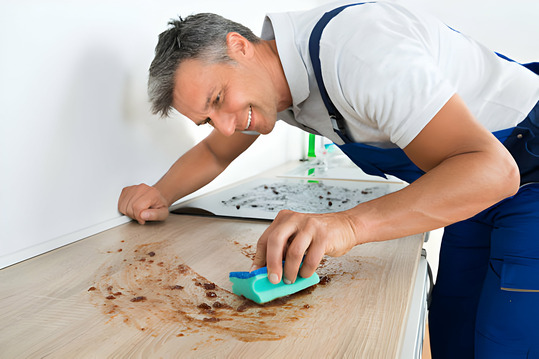
Cork flooring is a unique and eco-friendly option that adds warmth and character to any space. Whether you’ve recently installed cork flooring or you’re a proud owner looking to maintain its beauty, this guide is your roadmap to cleanliness and longevity. From routine cleaning to tackling stubborn stains, we’ll cover everything you need to know about how to clean and maintain your cork flooring.
Cork flooring is made from the bark of cork oak trees. Its natural properties make it resilient, comfortable underfoot, and an excellent insulator. Understanding the unique characteristics of cork is crucial for implementing the right cleaning and maintenance practices. Cork flooring boasts numerous advantages, including durability, hypoallergenic properties, and a natural resistance to mold and mildew. Recognizing these benefits helps you appreciate why cork is a popular choice for both residential and commercial spaces.
Cork flooring often comes with different finishes, such as wax or polyurethane. These finishes affect the cleaning methods you should use. Identifying the finish on your cork flooring guides you in selecting appropriate cleaning products and techniques. Proper installation is the foundation of a long-lasting cork floor. Ensure your cork flooring is professionally installed, leaving room for natural expansion and contraction. This step minimizes the risk of damage and ensures a stable surface. Cork flooring is versatile and suitable for various areas, including living rooms, bedrooms, and kitchens. However, understanding its limitations helps you make informed decisions about where to install cork flooring for optimal performance.
Here is our post on How to Clean and Maintain Your Porcelain Tile Flooring which you will not want to miss.
Routine Cleaning and Maintenance
Daily Dusting and Sweeping
Regular dusting or sweeping is essential for preventing the buildup of dirt and debris. Use a soft-bristle broom or a vacuum cleaner with a hardwood floor attachment to remove surface dust and particles. This simple step prevents scratches and maintains the floor’s appearance.
Damp Mopping with a pH-Balanced Cleaner
For routine cleaning, damp mop your cork flooring using a pH-balanced cleaner. Avoid excessive water, as cork is susceptible to moisture. A damp (not wet) mop with a mild cleaning solution is sufficient to remove everyday grime.
Choosing the Right Cleaning Products
Opt for cleaning products specifically designed for cork flooring. pH-neutral or slightly acidic cleaners are ideal. Avoid harsh chemicals, ammonia, and abrasive cleaners, as these can damage the finish and affect the appearance of the cork.
Dealing with Spills Immediately
Cork is porous, so it’s crucial to address spills promptly. Wipe up liquid spills with a soft, absorbent cloth to prevent the liquid from seeping into the cork. Quick action minimizes the risk of staining and water damage.
Protecting Cork Flooring from Furniture
Place protective pads or coasters under furniture legs to prevent scratches and indentations. Regularly check and replace these pads to ensure ongoing protection. Lift furniture rather than dragging it across the cork surface to avoid abrasions.
See also our post on How to Clean and Maintain Your Ceramic Tile Flooring
Tackling Stubborn Stains
Removing Grease and Oil Stains
Grease and oil stains can be challenging. Create a paste using baking soda and water, apply it to the stain, and let it sit for a few minutes. Gently scrub with a soft brush and wipe clean. Repeat if necessary.
Handling Red Wine and Berry Stains
Act quickly to tackle red wine or berry stains. Blot the stain with a clean cloth, then mix water and a small amount of dish soap. Gently scrub the stain with the solution and wipe clean. Rinse thoroughly to avoid soap residue.
Eradicating Ink Stains
Ink stains can be stubborn. Dab the stain with rubbing alcohol using a soft cloth. Be gentle to avoid damaging the finish. Wipe the area with a damp cloth afterward and dry thoroughly.
Addressing Pet Accidents
For pet accidents, absorb as much liquid as possible with paper towels. Clean the area with a mixture of water and a cork-friendly cleaner. Ensure the spot is completely dry to prevent odors and mold growth.
Handling Scuffs and Scratches
Minor scuffs and scratches can be addressed with a bit of finesse. Use a touch-up kit designed for cork flooring to fill in scratches. For deeper scratches, consult with a professional for refinishing options.
Seasonal and Deep Cleaning
Seasonal Inspection and Maintenance
With each change of season, conduct a thorough inspection of your cork flooring. Look for any signs of wear, damage, or changes in appearance. Addressing issues promptly helps prevent more significant problems down the road.
Deep Cleaning with a Cork Floor Cleaner
Periodically, engage in deep cleaning to rejuvenate your cork flooring. Use a specialized cork floor cleaner according to the manufacturer’s instructions. This process removes ingrained dirt and helps restore the floor’s natural luster.
Avoiding Excessive Moisture
Cork is sensitive to moisture, so it’s crucial to avoid excessive water during deep cleaning. Use a well-wrung mop or a damp cloth, and immediately dry the floor after cleaning to prevent water from seeping into the cork.
Applying Floor Wax or Finish
If your cork flooring has a wax finish, consider applying a thin coat of liquid wax or finish every few years. This step helps protect the cork and enhances its appearance. Follow the product instructions for best results.
Consulting Professionals for Refinishing
For extensive wear or damage, consult professionals for refinishing options. Refinishing can breathe new life into your cork flooring, addressing issues such as scratches, stains, or a worn finish. Professional refinishing ensures optimal results.
See also our post on The Complete Guide to Cleaning and Maintaining Your Laminate Flooring
Preventive Measures and Tips
Using Area Rugs and Mats
Place area rugs and mats in high-traffic areas to protect cork flooring. These provide an additional layer of defense against dirt, scratches, and wear. Choose rugs with non-abrasive backing to avoid damage.
Maintaining Humidity Levels
Cork is sensitive to humidity changes. Maintain consistent humidity levels in your home to prevent cork from expanding or contracting excessively. Use a humidifier or dehumidifier as needed, especially in climates with extreme variations.
Avoiding Direct Sunlight
Prolonged exposure to direct sunlight can fade cork flooring. Use curtains, blinds, or UV-filtering window film to minimize sunlight exposure. This preventive measure helps preserve the color and appearance of your cork flooring.
Regularly Trimming Pet Nails
If you have pets, keep their nails trimmed to prevent scratches on the cork surface. Additionally, place mats near entryways to capture dirt and debris before pets enter the living space.
Seeking Professional Advice
When in doubt, seek professional advice. If you encounter issues beyond routine maintenance, consult with flooring professionals or the manufacturer for guidance on the best course of action.
Click here to have a glance at our post on The Complete Guide to Cleaning and Maintaining Your Engineered Hardwood Floors.
Conclusion
Cork flooring is an investment in both style and sustainability. When you understand how to clean and maintain your cork flooring, you not only preserve its aesthetic appeal but also ensure its longevity. From routine cleaning practices to addressing stubborn stains and implementing preventive measures, this comprehensive guide equips you with the knowledge needed to keep your cork flooring looking pristine for years to come. Embrace the beauty of cork, and let your floors shine with the care they deserve.







